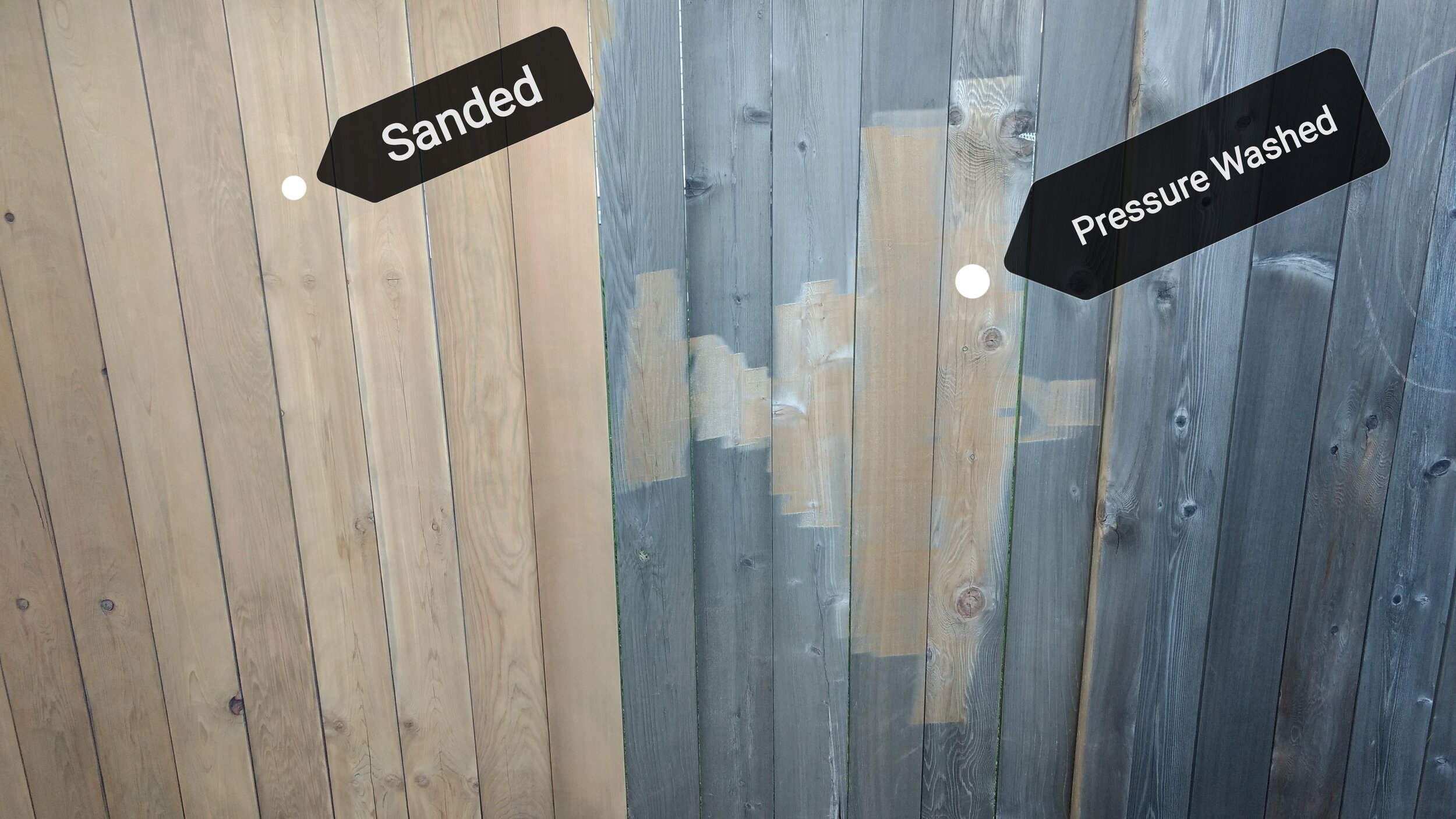5 Reasons You Should Never Pressure Wash Your Wood Deck
You want the best for your deck in care, protection, and aesthetics. Washing seems like a no-brainer to maintain it, so why not make your job easier with the power of a pressure washer? Here are 5 reasons we don’t pressure wash decks in our business, and why we think you shouldn’t pressure wash your deck either.
NOTE: We focus on the maintenance and care of wood decks and do not recommend pressure washing any of them (Cedar, Ipe, Accoya, Kebony, Thermory Ash, etc.) Pressure washing may be perfectly fine for your composite or PVC deck.
1) Risk of Damage
Tip Too Close To Wood
There are so many ways a pressure washer could damage your deck. If the tip is too close to the wood, it could split the soft grains and leave you with a super textured wood like from wire/nylon brushing or sandblasting. Since the hard grains and knots are so strong, they will remain intact, and you’ll be left with gouges where all the soft grain used to cut flush.
Too High PSI
Some pressure washers have an extremely high PSI (pounds per square inch). This sounds great in theory—more power to clean deeper and faster should be a good thing, right? Not for wood decks—especially since most wood decks are made from softwoods like pressure, pine, spruce, etc.
These softwoods are easily dented by pressure washers and won’t get their shape back. Even if you sanded the hard grains down to match, the damage could be extremely deep (several millimetres) and force you to sand way too much wood at one time. Not to mention, you’d have to sand your whole deck to match that gouge / hole, unless you wanted pooling in that one area.
Tip Heads
There are several tip heads you can use with a pressure washing system. The narrower the tip, the more isolated the pressure to that one spot, and therefore the more chance of damage. A wide fan would be the safer tip for softwoods, but still not recommended using the Sand & Stain System.
Even if you use a pressure washer with low PSI with a super wide fan and hold the tip far enough from the wood, there are other considerations to make in the decision of pressure washing your wood deck.
2) Tiger Striping
Much like staining, pressure washing should be done along the grains of the wood. Often, the urge to expedite the process leads to zigzagging and improper technique, creating a ‘tiger striping’ effect into the wood. Again, this is a damage that shows up in the wood is permanent, and too deep to sand out.
Tiger striping not only looks bad, but the indentation and removal of soft grain will allow for water to sit in those pockets. Worse yet, in winter, this water will freeze and expand and potentially crack the wood itself.
If you are familiar with our beliefs and process, you know we use only thin, transparent / translucent, true penetrating oils. If your deck has been tiger striped, every detail will show through with a transparent stain. Even if you use a thicker stain or solid / opaque stain, the texture of the pressure washing holes will still show.
Attempting to fill these holes with stain is a bad idea. For one, thick stains and any coating with a film forming technology will eventually peel (usually after one winter—or sooner with poor prep work.) Also, wood filler does not solve this problem and will eventually separate and fall out regardless from the shrinking and expanding of the wood from the changing seasons.
Stain is meant to protect from the inside out—the opposite of paint and top coatings. Therefore, covering tiger stripes will not solve the issue. Prevention of tiger stripes in the first place is a great start, and one more reason you should not pressure wash your wood deck.
3) Raises Wood Grain
Let’s assume you’re a pro. Either a contractor/business, experienced do-it-yourselfer, or extremely lucky individual that managed to pressure wash your deck without any damage. Now what?
Once your deck has dried, you’ll notice the dead wood fibers have lifted off your deck. They look like a bunch of tiny “fuzzies” matted on the surface of your deck. They are too stuck to peel off by hand, the deck is too soft to peel it off without denting with a scraper, and pressure washing a second time will create even more of a mess and still leave tons of these behind.
You definitely can’t stain on top of this. Your only option is to sand your deck to safely get rid of these fuzzy dead wood fibers. So if you need to sand the top layer of your deck after pressure washing, what was the essence of pressure washing in the first place?
NOTE: You should not have to sand your deck every time you want to re-stain or apply another coat. Check out our three part Sand & Stain System to maintain your deck so it never peels.
4) Elemental Damage
Deck floor suffers more than any other part of your deck. It gets walked on, rained and snowed on, shoveled, splashed by the salts and cleaning chemicals from your pool or hot tub, played on by your children and their sharp toys, spilled on by wine and acidic drinks and food from your parties and gatherings, scratched by your dogs and other pets, and the list goes on.
The point I’m making is your deck already gets enough weathering from the elements and wear-and-tear. Why risk abusing it even more with the damaging effects of a pressure washer?
It seems ironic to me that moisture and water is arguably the number one item we’re protecting against, and somehow we are sold the idea to use that very element to protect it. (I echo that same statement for why would you use a water based stain?)
Your deck should be a place to enjoy, to be proud of, and to care for. Protect it and decorate it without exacerbating it with more elements and risk premature weathering or damage.
5) Unneeded Process
Eliminating pressure washing can save time for DIY’s and save money if you are hiring a contractor or business and suggest you don’t want any pressure washing (or choose a business that doesn’t use pressure washers altogether, like our local Ottawa Sand & Stain chapter.)
For the contractors and small businesses reading this, you can see how removing this step from your process will save you tons of valuable days to spend on sanding restoration, and staining. In fact, the time you save is exponential, because not only are you saving the one day from pressure washing, but you are also saving the few days afterwards when waiting for it to dry.
What used to be a multi-day process can be done in one day (depending on size of job and number of staff.)
Sanding is 100% dry prep allowing penetrating oil based stain to be applied on the same day.
Applying stain immediately after sanding is a time saver. With pressure washing, not only do you need to wait for the wood to dry for a few days (allowing dirt and dust can get on the deck wood in the process), with the power of Murphy’s Law dictates it will rain while you’re waiting for your deck to dry, making the process even longer.
What’s the Solution?
It’s been stated in the reasons above that pressure washing can (and should) be eliminated entirely. To be clear, that does not mean you should never wash your deck. Using a common garden hose with a wide fan setting is more than enough to rinse off a powerful cleaner which can be dispersed with a pump sprayer.
Cleaning can be done at the beginning and end of season, or a few days before a re-coat application of penetrating oil stain. If you are preparing your deck for the first time, you will want to sand it to remove the mill glaze from the wood before staining it, but it won’t need to sanded for many years (or ever if properly maintained) when washed or cleaned without a pressure washer.







